Research notes from four students working on Contesting Closure
What the Jackman Scholars-in-Residence working with Dimitry Anastakis on GM plant closures have to say about oral history, archival research, agency, and field work.
Note: This blog post is cross-posted from the Ingenium Channel blog, with notes from four Jackman Scholars-in-Residence working with DePOT co-investigator Dimitry Anastakis on the “Contesting Closure: Life Stories of Work and Community in Oshawa’s Motor City, 1980-2019” project.
Authors: Han-Yi Huang, Ingrid Monsivais Ibarra, Jacob Harvey, and Sean Garner
Community, Camaraderie, and Producing Historical Scholarship,
Hang Yi Huang
Han-Yi Huang is a Masters of Arts student at the University of Toronto. She studies the history of drive-in churches in the United States and Canada.
In May 2022, I had the pleasure of working alongside five fantastic Jackman Scholars-in-Residence undergraduate students on a research project called Contesting Closure: Life Stories of Work and Community in Oshawa’s Motor City, 1980-2019. This project was led by Emily Gann of Ingenium — Canada’s Museums of Science and Innovation and by Professor Dimitry Anastakis of the University of Toronto. As a team, we created the groundwork for an innovative digital exhibit for Ingenium on the life experiences of former General Motors employees in Oshawa, Ontario.
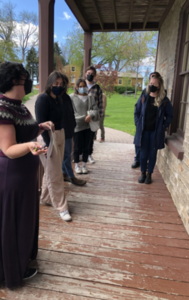
Contesting Closure Jackman Scholars-in-Residence team learning about Oshawa’s history during a field trip to the Oshawa Museum.
Together, we researched old newspapers, magazines, photographs, union newsletters, and other primary sources to learn more about the intertwined histories of General Motors Canada and the community of Oshawa. Many of us also conducted oral history interviews with workers and visited the Oshawa Museum, Unifor Local 222’s Union Hall, and the Canadian Automotive Museum. Throughout this process, I was continuously struck by how giving former General Motors employees were with their time and energy, and how museums in Oshawa embraced our project and were eager to share their resources with us.
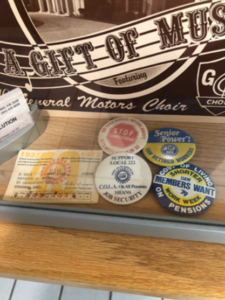
Unifor Local 222 Union Ephemera at their Union Hall in Oshawa.
In particular, former General Motors employees were incredibly generous to our team, sharing their time and expertise on their experiences working in Oshawa’s assembly plant and living in the community. As a team, we were able to conduct numerous oral history interviews with men and women who worked throughout the plant in different roles from the 1980s to 2019. Their union, Unifor Local 222, played an integral role in connecting us with interview subjects. They also invited us into their union hall where we were able to look at a wide assortment of Local 222’s ephemera, from buttons to union membership cards, dating from as surprisingly early as the 1930s!
The kindness of former General Motors employees and Local 222 was essential to the success of this project. In many instances, we were invited into their homes to ask questions and listen to their life stories. This experience has been incredibly fulfilling and humbling in many ways. It has challenged how I think about the “work” that goes into producing historical research and how scholarship should be conveyed and shared with people. Rather than conceptualizing historical research as a highly individualized task, I have learned about the importance of celebrating community and camaraderie in scholarship and reaching out to the wider community to learn about their stories.
Learning from Experience: Why We Need Oral Histories
Ingrid Monsivais Ibarra
Ingrid Monsivais Ibarra is a student at the University of Toronto. She is studying Economics and Women and Gender Studies, with an interest in how these disciplines overlap.
The large industrial footprint of the General Motors Canada manufacturing facility in Oshawa suggests the scale of its importance and influence in the surrounding community. I recently drove along the plant’s perimeter, where dozens and dozens of freshly-manufactured Chevy Silverados were arranged in neat rows, all waiting to be shipped across North America. I was struck by the enormity of this complex. I had spent hours reading about how the facility employed thousands of workers; I knew it was big. Still, there’s a major difference between understanding something by imagining it, and by experiencing it yourself.
When GM Canada announced in November 2018 that they would be shuttering the Oshawa plant later the following year, 2,500 jobs were threatened. After months of negotiations, the workers’ union Unifor reached an agreement with GM Canada to preserve 300 positions in its parts stamping division. This is a small fraction of the workforce that had once occupied the GM Autoplex in Oshawa. On shifting back to truck production in 2021, the manufacturer created 1,800 positions in order to support two shifts. It’s a whirlwind of a story, but it becomes all the more dramatic when we read these numbers not as jobs but as individuals. This change in thinking, coupled with the ability to speak to someone who lived through these events, can change and challenge our understanding of the very recent past.
As part of the Jackman Scholars-in-Residence program, I had the opportunity to interview a former GM Canada employee and union representative. Through this oral history, this individual shared stories of working at the plant and described what it was like dealing with this operational shuttering. Our conversation stood in stark contrast to the articles I had been reading for background research; here was a first-person account, coming from a perspective that was right on the level where everything happened. In this way, engaging with oral histories – spoken accounts of people’s personal experiences with historical events – places us directly in the middle of these events. We get as close as possible to having lived them ourselves.
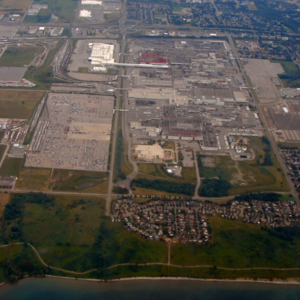
Aerial view of General Motors’ manufacturing facilities in Oshawa, 2012.
Likewise, when someone shares a memory with us, we can pick up meaning beyond the words we hear. The facial expressions people make as they talk, the places where they hesitate; these represent their own side of the story, which we can’t necessarily understand or infer from other primary sources. When we see or hear people speak, we begin to feel what they felt, to experience what they experienced – or as much of it as we’re capable of. We move beyond an intellectual grasp, and arrive as closely as possible to feeling the impact of these events, or of this history, ourselves.
And so, if firsthand experience offers a kind of understanding nothing else can, then oral histories – with the unique perspectives they offer, and the reflexive understanding they inspire – must be the key to making sense of events we haven’t lived ourselves. Oral histories are indispensable if we want to come close to understanding the past.
What Counts as History? Top-Down Versus Bottom-Up Agency
Jacob Harvey
Jacob Harvey is a recent graduate of the University of Toronto, holding an Honours Bachelor of Arts with a major in history and minors in political science and human geography.
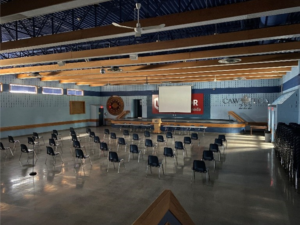
Unifor Local 222 meeting hall – a hub of rank-and-file activity.
Popular understandings of history often rest on the perceived achievements of “great men.” These retellings tend to structure their narratives around particularly prominent individuals or decisive political and cultural moments. Certainly, this approach can help to reveal the basic elements of an important historical episode – names, dates, and places, for example – but it tends to obscure the individual and collective efforts of people in their day-to-day life. Indeed, “Great Man” methodology generally assumes that these efforts flow from or are secondary to the decisions made by people in positions of power. It is not surprising, then, that when viewed from the bottom up rather than the top down, the historical record takes on a much different hue. E.P. Thompson, one of the leading practitioners of this social approach to history, discusses how the general public have not been given proper scholarly regard in his book The Making of the English Working Class. Instead, he is careful to highlight “the agency of working people, [and] the degree to which they contributed by conscious efforts, to the making of history…”
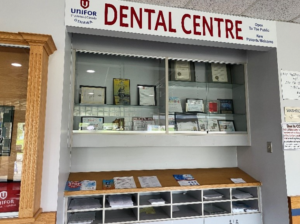
Local 222 Dental Centre and messaging board.
In researching the history of life and work at the General Motors plant in Oshawa, these methodological considerations were front and center. One of our research goals was to ensure that our work considered and captured the city’s industrial heritage in its totality. It would have been straightforward to explore deindustrialization in the city with reference to concepts like neoliberalism and globalization. High-level systems and processes like those certainly have had an impact on the auto industry in Oshawa. But grounding such concepts in individual and collective lived experience(s) helps to create a more nuanced appreciation of events. This informed our research approach; we gathered media and material artefacts to gain a sense of everyday life on the shop floor and in the union, and we conducted oral history interviews to preserve particular memories of working in the plant, of labour organizing in Oshawa, and of the local realities of deindustrialization. We hope that a bottom-up approach like this will allow people – GM workers, community figures, younger generations – to situate themselves within broader narratives and understand that they, just as much as politicians, corporate executives, and union leaders, are also meaningful agents of history.
Re-Examining Archival Research Following the COVID-19 Pandemic
Sean Garner
Sean Garner is a recent graduate of the University of Toronto, where he studied Political Science, History, and Canadian Studies.
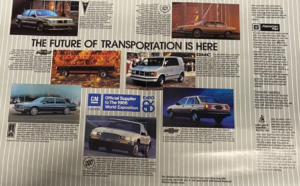
The contents of General Motors of Canada pamphlet for Expo 86
For much of the last two years, physical archives have been closed to researchers due to the COVID-19 pandemic. For example, the University of Toronto’s archival collections have been shuttered for in-person use, while their online collections and services have remained accessible. This shift to online access, despite being necessary and justified, has had a notable impact on academic research. Like many of my fellow students, during the pandemic I shaped my research around what was available through online archives. I thought myself well versed in navigating the cumbersome Library and Archives Canada interface, the captivating digitized photographs of the Toronto Public Library, and the virtual shelves of the University of Toronto’s Robarts Library. Although this online research is incredibly valuable, many institutions have not digitized their collections which has meant that, over the course of the last few years, these sources have not informed our scholarly analysis of the past.
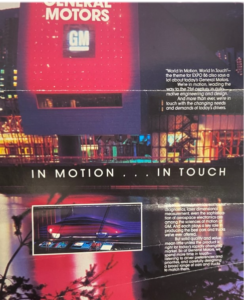
The front cover of General Motors of Canada pamphlet for Expo 86
Through the Ingenium-University of Toronto project “Contesting Closure: Life Stories of Work and Community in Oshawa’s Motor City, 1980-2019,” we travelled to Oshawa for an intensive research visit. Our day began with a tour of the Oshawa Museum. In the afternoon, a few members of our research team conducted oral history interviews with former GM Oshawa employees and I investigated the archives held at the Canadian Automotive Museum (CAM). Upon entering the archival collection’s room, the first thing I noticed was that history is, in fact, messy, as clichéd as it sounds. My only other encounters with in-person archival research had been to look at specific documents I knew were there. Instead, my search at CAM consisted of navigating through hundreds of boxes of documents, a mix of categorized and uncategorized material. Unlike the digital archives, there was no keyword to input to get me started. I opened a box, went through the contents, and moved onto the next box. I found things that did not relate to our project or our timeline. I also found material that provided new insights into our project. For example, prior to the trip to Oshawa, I had read about GM’s plan to respond to the forces of globalization and autonomation through implementing a “Factory of the Future” automotive production strategy. While in the archives at the museum, I found a GM pamphlet for Expo 86 that stated “The Future of Transportation is Here.” This pamphlet is material evidence of the implementation of a corporate strategy; it’s an incredibly rich primary source!
In reflecting on this experience, I’m struck by the ways in which an archive can allow for a physical connection with history. By actually interacting with these physical documents, I was able to connect my previous research to real, tangible evidence of past events. I could have, and am sure I will in the future, spend hours in the archives.




